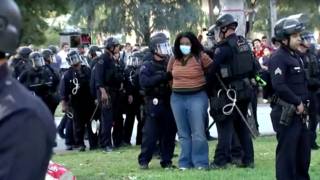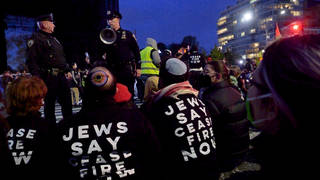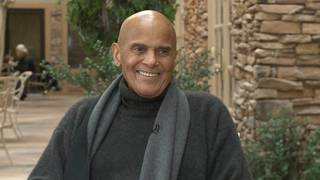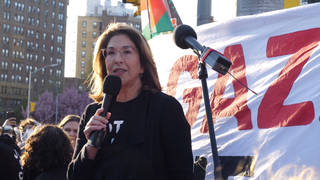
Related
Guests
- Isabel WilkersonIsabel Wilkerson is a Pulitzer Prize-winning journalist and professor of journalism at Boston University. She is the author of The Warmth of Other Suns: The Epic Story of America’s Great Migration.
We turn now to a pivotal but largely overlooked event in US history, the mass migration of millions of African Americans from the South during the period of the Great Migration, which began in the 1910s and continued to the 1970s. Award-winning journalist and professor Isabel Wilkerson has spent the last decade researching why millions of African Americans decided to leave the towns and farms of the South on such a large scale for her new book, The Warmth of Other Suns: The Epic Story of America’s Great Migration. [includes rush transcript]
Transcript
AMY GOODMAN: We turn now to a pivotal but largely overlooked event in American history: the mass migration of African Americans from the South to the North and West of the country. Some six million black citizens left the South during the period of the Great Migration, which began around 1915 and continued into the 1970s.
The Pulitzer Prize award-winning journalist and professor Isabel Wilkerson has spent, oh, close to fifteen years researching why millions of African Americans decided to leave the towns and farms of the South on such a large scale. Her own parents made this journey, from Georgia and southern Virginia to Washington, DC, where she grew up. Well, her book is just out, The Warmth of Other Suns: The Epic Story of America’s Great Migration. She’s also the the first African American woman to win a Pulitzer Prize and is currently professor of journalism and director of narrative nonfiction at Boston University. She joins me in the studio.
Welcome to Democracy Now!, Isabel Wilkerson.
ISABEL WILKERSON: Great to be here.
AMY GOODMAN: Absolutely remarkable book. What inspired you? Talk about your own family.
ISABEL WILKERSON: Well, in some ways, I think I grew up with the —- almost born to be writing this book. I mean, I was the child, the daughter, of people who migrated from the South to the North. My mother migrated from Rome, Georgia, a small town, to Washington, DC. In a different decade, a little later, my father migrated from southern Virginia to Washington, DC. There they met and married. And had it not been for this Great Migration, I wouldn’t be here. And I would be reading -—
AMY GOODMAN: Why did they leave?
ISABEL WILKERSON: They left because they wanted to be able to have better opportunities. They left because they were living under a caste system, which dictated and controlled every aspect of the lives of African Americans. In some ways I describe it as a defection as much as it was a migration. In many ways, they were seeking political asylum from a caste system that determined, for example, that in Birmingham, for example, a black person and a white person couldn’t play checkers together. Someone actually sat down and wrote that out as a law. There were places — there were courtrooms in the South where there was actually a black Bible and a white Bible to swear to tell the truth on.
AMY GOODMAN: You begin your book with the words of Richard Wright. Can you read them?
ISABEL WILKERSON: Yes, and I preface it by saying that, in some ways, it speaks to anyone who’s ever left one place that they — a place that they’ve never — the place that they’ve known all their lives for a place they’ve never seen. It speaks to the immigrant heart, and it reads, “I was leaving the South to fling myself into the unknown. I was taking a part of the South to transplant in alien soil, to see if it could grow differently, if it could drink of new and cool rains, bend in strange winds, respond to the warmth of other suns, and, perhaps, to bloom.”
AMY GOODMAN: And that’s where you got your title, The Warmth of Other Suns.
ISABEL WILKERSON: That’s where my title comes from, yeah.
AMY GOODMAN: So, in your book, you follow — you interviewed what? Twelve hundred people?
ISABEL WILKERSON: I stopped counting after 1,200.
AMY GOODMAN: It’s such a remarkable work and so beautifully drawn. The three different families that you follow illustrate the different migrations. Explain.
ISABEL WILKERSON: What the goal was was to capture the breadth and the scope of this migration, which was a national migration, from all parts of the South to all parts of the North, Midwest and West. In order to do that, I needed three people who would illustrate the three major streams of this migration.
So the first one was from — up the East Coast from Georgia, the Carolinas, Virginia, up to Washington, DC, Philadelphia, New York, Boston. That was the stream that my own family was a participant in. And the beautiful part about this whole migration is that it was very orderly; it was not just a haphazard unfurling of people. So, the person who represents that migration is a man who had — named George Starling, who had been — he had worked in the citrus industry. He’d been a fruit picker. He had also gone to college a little, had some college experience. And when he got out into the groves, he found that they were being mistreated horribly. It was dangerous work. They were being woefully underpaid. There was obviously no unionizing at that time. And he tried to organize the pickers to get a nickel more a box. And for doing that, his life was threatened, and he had to flee for his life. He left Florida for New York, for Harlem, in 1945.
The second stream was a stream from Mississippi and Arkansas to Chicago. And that was illustrated by Ida Mae Gladney, who was a sharecropper’s wife, who could — was very good in plowing and killing snakes, but she was very — really bad at picking cotton. She was really bad at picking cotton. And so, she was not much help in the field. Her husband and she and their two children left Mississippi for the North after a cousin had been wrongfully accused of a theft that he had not committed. The thing that they had accused him of stealing turned up the next day, but he had been beaten within — to within an inch of his life. And his — and when her husband discovered this, discovered the state that his cousin was in, he went home to his wife, and he said, “This is the last crop we’re making.” And they headed north to Milwaukee and then ultimately Chicago.
And the final leg of this migration, the final stream, is the one that’s written about the least, but in some ways is — some ways one of the most exciting things to write about, was the one from Louisiana and Texas out to the West, out to Los Angeles, Oakland and Seattle. And that was illustrated by Dr. Robert Joseph Pershing Foster, who was a surgeon in the Army during the Korean War. When he got out of the Army, it turned out he could not perform surgery or work as a doctor in his own home town of Monroe, Louisiana. And so he set out for a treacherous, unexpectedly treacherous journey across the desert at night alone, unable to stop. And that was a journey that I attempted to recreate myself.
AMY GOODMAN: And you did it with your parents.
ISABEL WILKERSON: I did it with my parents. I rented a Buick, as he had driven. He drove a Buick Roadmaster. And he would often say that if you had seen it, you would want it, too. He was a character in many ways. And we set out on this journey. And I told my parents, the rule was that only I could drive, because that’s what Dr. Foster had been forced to do. We got to the really treacherous part of the journey, where we were going — it was nighttime. We couldn’t stop, because he had not been permitted to stop. No one would take him in. He couldn’t find a room to stay.
AMY GOODMAN: Because he was black.
ISABEL WILKERSON: Because he was black. And he had not anticipated that. He thought once he got after — past a certain point, he’d be able to stop, but he found that not to be the case. And so, I tried to recreate that, and I wanted to experience what was it like to have your fingers get swollen from gripping the wheel for so long, for so many hours. Your eyes grow heavy, so heavy that they begin to ache. And yet there’s still more road, and there were hairpin turns, and it was dark, and you’re going miles upon miles upon miles. No settlements at all, even to this day. You’re driving around the mountains. They’re two-lane roads. And at a certain point, my parents said, “Let’s stop. Stop the car. Now. We must stop. And if you won’t stop, let us out” — because it was really — I mean, you’re going over the lines, and clearly I was weary and tired. We had no trouble finding a place, because it was no longer 1953, which is an indication of how far the country has come since that time. We still have a ways to go, though.
AMY GOODMAN: Isabel Wilkerson, talk about the Clarks and what happened to them.
ISABEL WILKERSON: The people in this migration experienced such hardship and repression in the South, so that by the time they got to the North —- it’s so disheartening to discover what they had to experience when they got to the North. In this case that you’re speaking of, it’s the Clark family, Harvey Clark and his wife. They had two adorable children, maybe four and six. And he had a pretty good job. He was an Army veteran, and he had a pretty good job as a bus driver, pretty well paying at that time. We’re talking the early ’50s. And he needed to find a place for his family to stay. They were all -—
AMY GOODMAN: Where did they live?
ISABEL WILKERSON: They were living in Chicago, on the South Side of Chicago.
AMY GOODMAN: But they had come up.
ISABEL WILKERSON: They had come up from Mississippi as part of this Great Migration. And they found themselves, which is the case for most African Americans in this circumstance, they found themselves hemmed in to very restricted islands within certain sections of a particular city. And it didn’t matter which city you’re speaking about; it happened in many of these cities. But this happened to be Chicago. They were actually sharing an apartment with another family, so they were overcrowded as it was. And they found a new apartment. They were so excited about it, because, actually, rents were higher for African Americans in those hemmed-in places, because there was no competition. What choice did they have? So he found an apartment for his family in a suburb called Cicero. And they were so excited, because they were going to be getting more space for less money, and it was — it seemed to be a nice, safe neighborhood.
Well, when they moved — when they tried to move in, they were not permitted to do so. They had to go to court in order to even move their belongings in. When they moved their belongings in, they could then not move themselves in, because a mob of several thousand gathered around and prevented them from actually moving in. Ultimately, those people went into this apartment building, went into their apartment on the second floor, ransacked it, threw all of their belongings, including the piano and sofas and chairs — they even pulled out the fixtures, the radiators — and threw them out the second-floor window. And then they set everything afire. Then they set the entire building afire, which then left the white people who were living in the building homeless. And that was in the early '50s. Not that long ago.
AMY GOODMAN: That was their welcome to the North.
ISABEL WILKERSON: Yes.
AMY GOODMAN: And that goes to this other issue of the tremendous risk that people were taking. They had no idea what would happen to them at the other end.
ISABEL WILKERSON: I think it's an indication, though, of how bad things were for them where they were living. I mean, to go back into the era — one of the goals of this book was to try to put the reader into this world, which is almost hard to imagine now. And it was not that long ago. It really wasn’t. It’s within the lifetimes of many people who are living today.
AMY GOODMAN: Which is also why you wanted to do this now.
ISABEL WILKERSON: Which is why I wanted to do it. I felt a great urgency to reach these people before it was too late. The idea was to try to make this come alive. And so, the lives that they were leading in the South, where their every move was dictated by the laws of Jim Crow, this caste system, as I describe it, and there were also — there was a lynching every three days during the period leading up to this Great Migration. So these were — they had, really, very little in the way of options. Everyone who was African American in the South at some point had to make a decision whether they were going to leave or whether they were going to stay. And these are the brave people who made the decision to leave. They left everything they knew, mother, father, kinfolk, the land that they knew —-
AMY GOODMAN: Property.
ISABEL WILKERSON: —- property. Everything. And there was — this was before the days of cell phones and easy long-distance, Skype. I mean, there was — really, they were turning their back, perhaps forever, on all that they had ever known to make this great risk.
And yet, what they —- their expectations and their dreams, in some ways, were quite modest. They weren’t looking to run Fortune 500 companies necessarily or to own skyscrapers. They were essentially looking for the freedom to be able to walk the streets freely, to be able to apply for a job that they felt that they could qualify for, to be able to get paid. I mean, the idea of being paid fair wages for their hard work was unknown to them in the South. So they were also looking for the opportunity for their kids to go to good schools. Many of them had not had the opportunity to do that. Clearly, they had gone to segregated schools that were clearly separate and not equal. So, by simply leaving, simply the act of leaving meant that their lives were going to be modestly better. So when we talk about the assessment of this Great Migration, what did it mean? How successful was it or was it not? In some ways, when you look at what did these people want, leaving was, in a way, its own point, and they achieved something just by leaving. There are many other things in the aftermath of it, but they could -—
AMY GOODMAN: It’s a declaration of independence.
ISABEL WILKERSON: It’s a declaration of independence in the true sense of the word. It was the Emancipation Proclamation actually put into effect by the people themselves, because it had not been lived up to in the South.
AMY GOODMAN: This migration, of course, not just affected the people who went on it — six million people — it restructured America.
ISABEL WILKERSON: It restructured America, restructured the North and the South. The majority of African Americans that you meet in the North, the Midwest and West are products of this Great Migration. There are so many aspects of life and culture, American culture, that we take for granted. I mean, literature, for example, Toni Morrison, August Wilson, the playwright, Lorraine Hansberry, the playwright, Richard Wright himself, the great novelist — all of these people were products or part of the Great Migration. So that’s literature.
When you talk about music, it’s hard to imagine music without this Great Migration. These people brought with them the music and the folklore and the sounds and the language and the food of their home country, you might say, their homeland, and transformed American culture as we know it. Motown simply would not have existed had there been no Great Migration. It wouldn’t have existed because Berry Gordy, the founder of Motown, his parents migrated from Georgia to Detroit. And there, once he grew up, he began to look around. He decided he wanted to go into music. He didn’t have the money to go scouting all over the country. So what did he do? He actually drew from the people, the children around him, the young people around him, the —- Diana Ross and Smokey Robinson, all of these people were children of the Great Migration. They might not even have existed without this migration. That’s -—
AMY GOODMAN: B.B. King, Ralph Ellison.
ISABEL WILKERSON: Ralph Ellison. When it comes to jazz —-
AMY GOODMAN: Langston Hughes.
ISABEL WILKERSON: Jazz might not even be what it is today at all. Miles Davis, his parents migrated from Arkansas to Illinois, where he had the luxury, truly the luxury, compared to what he would have had, had he been growing up in the cotton country of Arkansas, where they work from sunup to sundown. He wouldn’t have had the luxury of being able to practice for hours upon hours, you know, his music. That would have been a self-indulgent luxury. The same goes for Thelonious Monk, who migrated -— his parents migrated from North Carolina to New York when he was five years old, where he, too, got the luxury of being able to practice for hours on end. He would never have been able to do that, take music lessons here in New York — they would never have been able to do that in the tobacco country of North Carolina. And John Coltrane. John Coltrane actually migrated from North Carolina to Philadelphia when he was seventeen, and it was there in Philadelphia that he got his first alto sax. Where would we be, had he not gotten the alto sax?
AMY GOODMAN: Of course, not Coltrane takes me to trains.
ISABEL WILKERSON: Yes.
AMY GOODMAN: You described driving, as some people did. Other people took trains. And the seminal role that the trains played — I mean, you had the organizing by A. Philip Randolph —-
ISABEL WILKERSON: Mm-hmm.
AMY GOODMAN: —- for the Brotherhood of Sleeping Car Porters, and the porters themselves, the conductors.
ISABEL WILKERSON: Absolutely. Well, there’s several things that come to mind when you mention the trains. One is that this was a fairly orderly redistribution of an entire people, because they followed — the routes were not accidental. The routes were as predictable as the fact that if you go to Minnesota, you’ll find that there are many people from Sweden and Norway. So people went — in the United States, they went along the railroad lines, the bus routes and the tracks that had essentially been laid by those who had gone before them. So it was very orderly. So if you were to go to Chicago, you would find that the majority of people who are African American there are from Mississippi or Arkansas. In fact, there are more people living in Chicago — more African Americans in Chicago than in the entire state of Mississippi, which is the state from which they had come, which is astounding. Astounding fact in and of itself.
Also, when it comes to the trains, I’m also reminded of the fact that the trains were essentially freedom trains for them, because the trains represented the only way out. And they often had a difficult time even getting on those trains. The South went to an enormous effort, incredible efforts, to keep them from going. They would — the authorities would come and arrest people wholesale on the railroad platforms. They would board the trains and pull off workers, because that’s essentially what they were doing. They were essentially going in and arresting people who were trying to leave the South, because they were losing their cheap labor. I mean, many of these people were not being paid anything, but just for the right to live on the land they were farming. And so, these people, the South did not — was not going to let these people go easily. So it was a great — took great courage, often planning and fortitude and resolve and determination, and perhaps desperation, for the people to get up the courage in order to leave and, in some ways, defy their own leadership to do so.
AMY GOODMAN: Isabel Wilkerson, it’s been fifteen years. It’s actually been your life, because you, your parents did this. What surprised you most in writing this?
ISABEL WILKERSON: I think what surprised me most is that the research actually affirmed so much of what I grew up with. I grew up in a world in which almost everybody was from North Carolina, South Carolina, Georgia, and people worked really hard. People worked multiple jobs. People were very competitive about what they were going to — how their kids were going to do better in the North. They had to prove that their decision was the right decision. Failure was not an option for these people. And so, many of them — the data now bear out the fact that these people were more likely to remain married — they felt they would do better if they were married — that they actually were more likely to be raising their children in two-parent households than the African Americans that they met in the North, that small core of people who were already there. They were actually making more money, more money in the aggregate than the people who were already there, and that’s because they weren’t necessarily being paid more per hour, they working multiple jobs, like any other immigrant group who often comes to this country. And to me —-
AMY GOODMAN: We have twenty seconds.
ISABEL WILKERSON: —- the goal would be that we all recognize that we have so much more in common than we’ve been led to believe.
AMY GOODMAN: Well, I thank you for this remarkable work. It is called The Warmth of Other Suns: The Epic Story of America’s Great Migration. It’s by the Pulitzer Prize-winning journalist, professor of journalism at Boston University, Isabel Wilkerson.
Watch Part II of this Conversation












Media Options